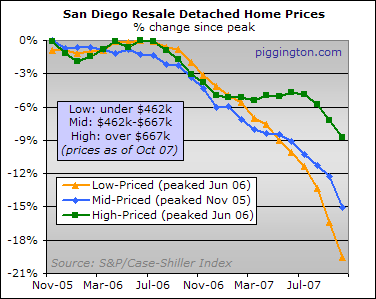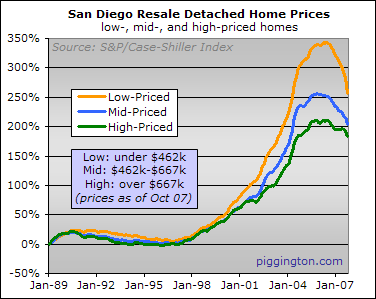The aggregate Case-Shiller HPI for San Diego declined by 2.6% in October — the steepest one-month decline to date and the worst single-month drop among all the cities tracked by Case and Shiller. Here’s a look at how the different price tiers have fared since the decline began:

The aggregate index is down 13.3% since its November 2005 peak.
This longer-term look at the price tiers puts the relative strength of the high tier into perspective:

The October HPI is calculated from sales that took place in August, September, and October. Meanwhile, the price declines seem to have been accelerating each month (the size-adjusted median price for single-family homes was down 3.6% between October and November). So while the Octobe HPI may look bad, December reality is surely worse.

I would agree with you Rich
I would agree with you Rich about December and the upcoming months. Moreover, I have seen a more responsive stance from lenders on short sales and repos such that those medians should get tugged down significantly after severe reluctance earlier in the year. Additionally the low ends will get hit harder per the trend.
SD Realtor
LA, (for those concerned)
LA, (for those concerned) was down 2.08% Sep-Oct, and 8.83% from last October. And if I’m reading the numbers correctly LA’s drop is the biggest month to month drop to date also.
It’s interesting to look at the month to month data trends. We often dismiss month to month, and rightly so iosloated, but looking back to the start of the data you see trends that indicate this 2-3% drop could likely occur again, once the perma bulls call the bottom following the next seasonal up-tick.
Wowee.
I find it really
Wowee.
I find it really interesting how the high tier sputtered along for a while and then about a year ago started the plunge.
If there is symmetry, the high end should not begin to plunge in earnest for another six months or so.
Man, that low end is brutal, just brutal. My heart goes out to all the earnest folks who bought starter homes in that range. To all the speculators buying those houses, well, you play with fire …
My heart goes out to no one.
My heart goes out to no one. They shoudn’t have bought something they couldn’t afford. They all deserve to lose there homes.
What is most stunning to me
What is most stunning to me is that if you look at the low end peaking in June 2006, it is down about 20% in 16 months.
Why is that so surprising (I
Why is that so surprising (I interpret stunning as surprising)? If you look at the graph, rise and fall of lower income is completely symmetrical. That is what one would expect, the fall is equally strong and irrational as the rise that led to it.
Gutspeak
“What is most
Gutspeak
“What is most stunning to me is that if you look at the low end peaking in June 2006, it is down about 20% in 16 months.”
How fast did it RISE 20%? prolly fastern 16 months…
Curious how these tiers are
Curious how these tiers are determined, as there are numerous areas in both San Diego, Orange and LA counties that don’t have any single family homes in the “low” range, or even the “mid” range for that matter. I live in one of those areas in LA county, and it’s a very average bedroom community. Seems to me these ranges need to be expanded to reflect the sad reality of So Cal pricing.
BobS
I have a theory that
BobS
I have a theory that due to a combination of time lags and mass psychology, the biggest part of this price drop will occur in mid-2008.
We economists recognize several time lags in cycles between an event and the full flowering of its effects. Here the time lags are both large and farther reaching than generally recognized. My point is that these time lags will exacerbate and lengthen the extent of the price decline.
Consider what happens when announced prices have been going down for some two years as they have to date. The journalists are only now recognizing and reporting honestly (mostly) on this, even though “insiders” on this site have long known it. That is the time lag between the start of the price decline in mid-2005 and now. Then there is the time lag between the publicity and the education of the general public, a process now happening, but slowed and hindered by the publics’ reluctance to embrace the idea that their net worth is evaporating in front of their eyes. Then there is the time lag between their acceptance of that fact and their actions–namely lowering their prices on for sale real estate…a process in which they will lower prices belatedly and reluctantly, always chasing a falling market. These forces will combine to accelerate the decline now underway, probably climaxing in mid-2008.
Another bunch of time lags brought up on this site is in the foreclosure process–starting with a homeowner getting behind on payments (several months), the filing of the NOD and three months to publication, about a month or more (depending on negotiations) to actual auction where it doesn’t sell, to a new REO on the market at an unrealistic price (perhaps delayed by fix-up time and costs by the bank), to a final capitulation by the lender to sell at the true market price, and finally to the publicity of that new low price and dissemination & publicity of that new price level to the general public. All these time lags could total one year, and easily more.
The biggest mistake one could make now is to justify buying today because documented prices have fallen. RE salespeople can and are making a persuasive argument to buying now by pointing out the price declines. They will sucker in a lot of people with this approach. But before prices ever start going up, they will have to level out for some period of time. Before they level out, they will have to decline slowly to approach that bottoming-out time period. Before they decline slowly, they will be declining rapidly. What are they doing now, based on the latest from Case/Shiller? THEY ARE DECLINING AT AN ACCELERATING RATE. Accordingly, this is a time for investors with a sense of history to get liquid, raise your FICO score, and, as J.P. Morgan famously said, only buy when there is blood in the streets.
Heard Dr. Shiller on KNX
Heard Dr. Shiller on KNX yesterday… he commented that based on the Oct. numbers San Diego now ranks second only to Detroit in the extent of home price declines. I believe he also said that the declines have now surpassed the inflation adjusted numbers from the declines of the early nineties. Appearing not to take any tiers into account, the numbers he gave for San Diego are 11.1 percent year over year through Oct. and 18 percent since the ‘peak.’ On a broader note he seemed surprised by the present ability of the consumer to continue to prop up the economy. He didn’t seem to think that could last much longer, but didn’t rule out the possibility of avoiding a recession. He said the biggest factor on the economy however was the housing market and what is adding up to national equity losses into the trillions.
I’d agree Bob. Perception of
I’d agree Bob. Perception of declining prices is only starting to hit the masses. People had it ingrained in their heads that home prices NEVER go down. Once they recognize it and accept it, I think a lot of people will walk, cut prices, or take them off market if they can afford to stay, and be more apprehensive to buy.
If you graph out the month to month changes in precentages over the last 20 years it’s quite erratic so you can bet we will see an increase at some point whereby Liar Lawrence will call the bottom and insist it’s time to buy.
There’s still a long way to go, and even 2-3 consecutive months of average price increases measured by any method do not necessarily indicate the bottom has passed.
Bob good post…
“All these
Bob good post…
“All these time lags could total one year, and easily more.”
I tend to think more. I also tend to feel that the lags shmear across the desireability/income spectrum in an uneven manner. Also that the distress factor tends to follow in the same manner. Obviously different levels of distress occur in different income/desireability strata with respect to housing. You get more of a schmoo so to speak.
In essence I do agree with the statement that we are just now coming up to the funnest part of the ride however I think that there will be uneven durations of those steep slopes. At some point neighborhoods will hit break even and positive cash flows. Will it be in 08? 09? 10? Don’t know. Alternately we may not even see the steeper slopes in the highly desireable areas until later, 09 10? because of lack of distress needs to be supplemented by unemployment.
Hard to say… I agree with the point but tend to schmoo the process more temporally over the distribution of sellers/regions.
D Realtor
BobS
Good points Coop and
BobS
Good points Coop and SDR.
Of course no one can predict the velocity and eventual depth of the current market decline. Factors yet to occur (assasinations, anyone?) can happen. Economists with the best forecasting record have the simplest method: Take the trend of the most recent months, then extrapolate into the future.
We do know that the price decline from the mid-2005 peak is now accelerating, according to Case/Shiller. Accordingly, we are a long way from the price decline moderating, much less leveling off in the distant future.
Others here have made the valid point that price cycles tend to revert to the mean over the long haul. If so, then the wild excesses of this runup compared to previous price runups should make for a deeper and longer decline. Check the graph posted by Mark Holmes at 1:50 today under the thread “I really want to buy…” to see how radically different this 2005 price peak was compared to previous ones. (if I were not so new to this game I could paste it below…maybe someone else?) This housing price cycle will be one for the history books.
crosspost from Bigger Boom,
crosspost from Bigger Boom, Bigger Bust thread:
Looking at the HPI numbers, the mid-90’s bottom is not at all apparent. However, if one adjusts the HPI numbers for CPI inflation, which is about 2.9% per year, the bottom is clearly apparent in early 1997 – about seven years from the prior peak.
With inflation, SD aggregate has already fallen 17%.
If one assumes constant inflation at the historical average, and the bottom of this cycle does not hit until 2012, and the bottom hits the same level as the 1997 bottom, nominal prices will decline 50% more.
This actually makes intuitive sense, given the declines that have already taken place, and the fact that we are only about two years into the down slope.
———
It seems hard to imagine price to rent ratios going that far to the other side, but then again, I recall it being quite a bit cheaper to buy than to rent in San Jose in 1993.
One for the history books, indeed.